
Fabry, Inc., Antioch, Illinois
Saint Laurence Catholic Church, Elgin, Illinois
The original twelve-rank organ by H. A. Howell Pipe Organs of Dixon, Illinois, was installed in the First Presbyterian Church in Oregon, Illinois. The church was sold to Al and Jill Millhouse and Bill McKay, who repurposed the building as a daycare facility. There was no need for the organ, and the owners decided to donate this instrument to Saint Laurence Catholic Church in Elgin, Illinois.
Fabry, Inc., was contracted to remove the instrument in 2021 and stored it at its factory in Antioch, Illinois, until there was time to undertake the rebuilding of the organ. Immediately after January 1, 2022, the instrument was brought into our shop facility to be re-engineered and to have a Peterson ICS-4000 control system installed. At that time the Elgin church elected to purchase two used ranks from our inventory to enhance the present specification: a 4′ Spitz Principal for the Swell division and a 22⁄3′ Twelfth for the Great division with two new chests constructed by Fabry, thus bringing the instrument to fourteen ranks.
The original installation in Oregon placed the instrument in a chamber with seventeen principal pipes exposed in the façade. Because our installation would have the organ sitting in the balcony it required us to furnish and install new casework and a swell enclosure. David G. Fabry designed, built, and installed the casework with the exposed pipes.
The dedication concert was played by Stephanie Gurga on June 26, 2022. Fabry, Inc., would like to thank Father Andrew Mulcahey, pastor, and Mrs. Kim Bianchi, director of music ministry at Saint Laurence Catholic Church, for their help, support, and cooperation during this project. A special thank you goes to Al and Jill Millhouse and Bill McKay for their generous gift to Saint Laurence.
—Fabry, Inc., Pipe Organ Builders
Antioch, Illinois
GREAT (Manual I, unenclosed)
8′ Principal 61 pipes
8′ Hohl Floete (1–12 fr Sw 8′ Ged, 13–61 from Sw 4′)
8′ Gemshorn (Sw)
8′ Gemshorn Celeste (TC, Sw)
4′ Octave 61 pipes
4′ Gemshorn (fr Sw 8′)
2-2⁄3′ Twelfth 61 pipes
2′ Principal (ext 8′) 24 pipes
II Mixture 122 pipes
8′ Trompete (Sw)
Chimes 21 tubes
Great 4
Swell to Great 16
Swell to Great 8
Swell to Great 4
Pedal to Great
SWELL (Manual II, enclosed)
8′ Gedeckt 61 pipes
8′ Gemshorn 61 pipes
8′ Gemshorn Celeste (TC) 49 pipes
4′ Spitz Principal 61 pipes
4′ Hohl Floete 61 pipes
2-2⁄3′ Nasat (TC) 49 pipes
2′ Gemshorn (ext 8′) 24 pipes
1-3⁄5′ Terz (TC) 37 pipes (top octave repeats)
1′ Siffloete (fr 8′ Gemshorn, top octave repeats)
8′ Trompette 61 pipes
8′ Regal (prepared)
Tremolo
Swell 16
Swell Unison Off
Swell 4
PEDAL (unenclosed and enclosed)
32′ Resultant (wired)
16′ Subbass (ext Sw 8′) 12 pipes
8′ Offen Bass (Gt 8′)
8′ Gedeckt (Sw 8′)
8′ Gemshorn (Sw 8′)
4′ Choral Bass 32 pipes
4′ Flute (Sw 8′)
II Mixture (Gt)
16′ Posaune (prepared)
8′ Trompette (Sw)
4′ Regal (prepared)
Great to Pedal 8
Great to Pedal 4
Swell to Pedal 8
Swell to Pedal 4
29 stops, 14 ranks, 837 pipes






